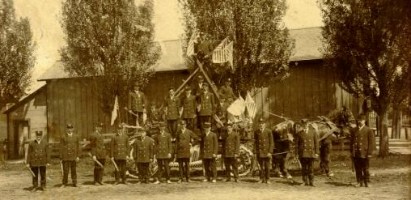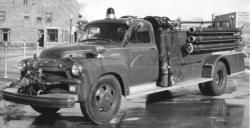Fire Department
The history of the department dates to the timber boom years of the late 1800’s when Tomahawk was founded. Before 1886, the area was covered by thick forests of pine and was mostly uninhabited. In late 1886, the Tomahawk Land & Boom Company set up operations here and in the following year laid out the site for the city.
By autumn of 1887, the Chicago, Milwaukee & St.Paul Railroad had reached “The Forks,” as the area was then known, bringing merchants, land speculators, lumberjacks, mill workers and others who hoped to find prosperity and a fresh start in the new settlement. Dams were constructed to form holding ponds for logs used by the sawmills and shingle factories, which were turning out building materials for the local market and to help meet the needs of the construction boom taking place in the cities of Milwaukee, Chicago and elsewhere. Tanneries, box plants, stave mills and carpentry shops also made use of the abundant supply of wood and wood by-products.
There was a down side to this boom period, however, that was recognized by the early inhabitants. A repeat of the horrible forest fire that swept through Peshtigo on October 8th, 1871, was a very real danger. That fire wiped out not only thousands of acres of cut-over lands, but everything in its path including the entire settlement with a tremendous loss of life.
The wide scale logging taking place in the vicinity of Tomahawk had left behind the limbs and tops of the downed pines and long, dry summers would leave this waste easily ignited. Additionally, most buildings in the soon-to-be city were of simple wood construction and were usually built close together, with little or no fire-stopping design or material built in. The mills, plants and factories that relied so heavily on the timber accumulated vast amounts of waste and scrap that added to the potential for catastrophe.
With this danger in mind, efforts were made at fire suppression within the village. Pails of sand were kept handy, and ponds, barrels and cisterns of water were located in many areas, along with buckets or simple pumps to apply it to any fire that might occur. Smoking was forbidden in most work areas, and machine belts and bearings were watched carefully for signs of overheating. These precautions no doubt prevented or lessened the damage from fires. However, many fires quickly outgrew the resources available to extinguish them and proved costly in both lives and property. The settlers realized that a more organized effort to contain fires was needed. Those needs were addressed as the settlement moved to become a city.
One of the first orders of business, after the city’s incorporation in 1891, was the funding and construction of a water works and the hiring of an engineer. Water mains and hydrants were laid out and installed, providing a more reliable means of water supply. While fire hydrants are for the most part taken for granted today, their introduction back then revolutionized firefighting. The availability of an easily accessible water supply allowed firefighters to go from what had been a mostly defensive style, where buildings were expected to be lost and efforts were concentrated solely on containing the spread, to an offensive style that halted and then extinguished the fire where it was. (Leaks were common in the early system, however, and low water pressure was a chronic problem until the late 30’s, when the present wells and mains were installed.)
By early 1892, a fire department consisting of a hose company and a ladder company was instituted as an adjunct to the water department, with Robert McGregor appointed as Fire Chief. A pair of high-wheeled hose carts and a hook and ladder truck (wagon) were purchased along with 2,500 feet of 2 1/2″ canvas hoseline. Funds were authorized for the construction of a two-stall barn to house the new equipment on the site of what is now Sieg Auto Parts. After a short period, Robert Thielman succeeded McGregor as Chief. The many difficulties faced by the early department proved to be overwhelming and after struggling to establish itself the department failed, disbanding in 1893.
In 1894 the Tomahawk Volunteer Fire Department was formed with Matt Stutz named as Fire Chief along with a City Council approved roster of 22 firefighters. This last formation, with few modifications, has continued to operate to the present day. Most of the changes that have occurred have been in the area of operations. Personal protective clothing, tools, equipment, apparatus, and communications among others have all improved from advances in design, materials and technology.
LT Brian Morren, Secretary TFD, June 4th, 1994








